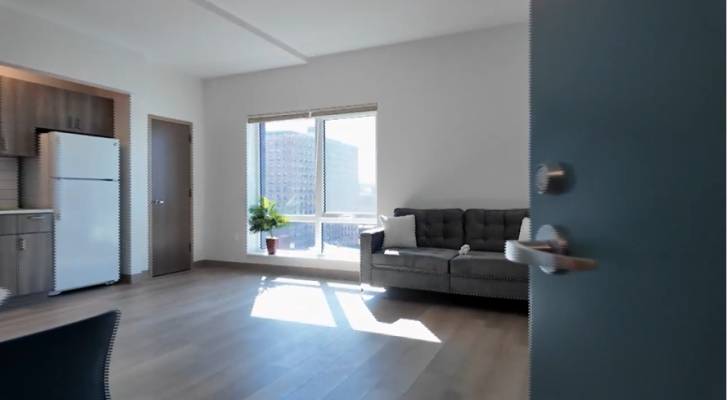
There’s relief for some NYC residents who are struggling to find budget-friendly housing.
Low income and homeless New Yorkers can now live in an affordable housing building located in Bed-Stuy, offering a sense of security to those who live there.
Don’t miss
- I’m 49 years old and have nothing saved for retirement — what should I do? Don’t panic. Here are 5 of the easiest ways you can catch up (and fast)
- Gain potential quarterly income through this $1B private real estate fund — even if you’re not a millionaire. Here’s how to get started with as little as $10
- Car insurance premiums could spike 8% by the end of 2025 — thanks to tariffs on car imports and auto parts from Canada and Mexico. But here’s how 2 minutes can save you hundreds of dollars right now
“I have no words for how much this building has helped me,” Elvis Jordan, a current resident of the building, told News12 Brooklyn.
Residents receiving housing support
Woodhill II Residence is a building with 36 units meant for adults who have health-related issues and could face homelessness.
The building is situated across from the NYC Health + Hospitals/Woodhill and helps those living with chronic health conditions and serious mental illness. Residents are referred through the hospital and can receive regular visits from health care providers directly from there.
Those living at Woodhill II Residence can also receive services like health care integration and case management. However, residents’ ability to stay in the building isn’t predicated on receiving treatment.
The organization that manages the building is CommuniCare and Blanca Ramirez, its CEO, says there is no time limit as to how long people can stay there. As long as residents can keep paying rent, they’re welcome to stay.
Rent at Woodhill II Residence is much lower than what you’d find in many other places. Residents could pay as low as $250 per month, or 30% of the Area Median Income (AMI).
How to seek affordable housing
If you’re finding it extremely difficult to afford housing, there are several options available to you. Here are the four main types of government programs that help you find affordable rental properties.
Subsidized housing
This government program will pay owners of apartments to help reduce the rent for qualifying low-income residents.
Eligibility is based on your household’s annual gross income and whether you have qualifying immigration status. In general, if you make less than a certain percentage of the median income in your area, you may qualify.
To determine whether you qualify, contact your local public housing agency. If you are, you can use the U.S. Department of Housing and Urban Development (HUD) housing map to find participating apartment complexes.
Read more: Want an extra $1,300,000 when you retire? Dave Ramsey says this 7-step plan ‘works every single time’ to kill debt, get rich in America — and that ‘anyone’ can do it
Housing Choice voucher program
Also referred to as Section 8, this program offers vouchers for paying part or most of your rent at qualifying housing units.
To be eligible for the program, you need to be at or under the HUD income limit, an eligible U.S. citizen or non-citizen, be free of certain crimes, and have a valid Social Security number for the head of household.
You can apply through your local Public Housing Agency. Keep in mind that there may be long waitlists because of the high demand. In the meantime, you can gather paperwork such as proof of income, documentation of any public assistance you receive and proof of citizenship.
Those that are approved for Section 8 housing assistance will need to attend a voucher orientation and tend to have from 60 to 120 days to find suitable housing.
How much rent you’ll pay depends on your Family Rent Portion, or Total Tenant Payment. At minimum, you’ll usually be on the hook for 30% of your adjusted monthly income, but it could be as much as 40%.
Public housing
Instead of renting through a private tenant, you may qualify for housing managed by your local public housing agency. Eligibility requirements are generally the same as subsidized housing.
In many cases, you may need to apply for public housing in person, though it can vary from state to state. Your local agency should help explain the process and provide you with which documents you’re expected to bring to your appointment.
Assistance for veterans and the disabled
The Supportive Services for Veteran Families (SSVF) program offers assistance for low-income veterans.
Some affordable housing solutions the organization helps with include offering financial resources to prevent eviction, get re-housed quickly if facing homelessness, and finding more suitable housing.
Typically, you’ll need to be very low-income, and a veteran or live with the head of household who is one.
Those living with a disability and under 62 years old may be able to receive a non-elderly disabled (NED) voucher. This is similar to Section 8 housing where you’ll receive assistance in paying for and finding affordable housing.
All of these abovementioned programs help to relieve the burden of living on a low income. If you still struggle to budget the money you earn, consider reaching out to local nonprofits or other relevant government agencies for assistance on necessities like food and health care.
What to read next
- Thanks to Jeff Bezos, you can now become a landlord for as little as $100 — and no, you don’t have to deal with tenants or fix freezers. Here’s how
- Here are 5 ‘must have’ items that Americans (almost) always overpay for — and very quickly regret. How many are hurting you?
- Trump warns his tariffs will spark a ‘disturbance’ in America — use this 1 dead-simple move to help shockproof your retirement plans ASAP
This article provides information only and should not be construed as advice. It is provided without warranty of any kind.